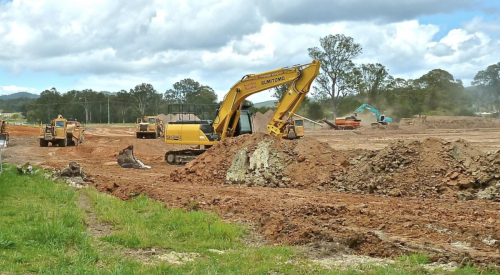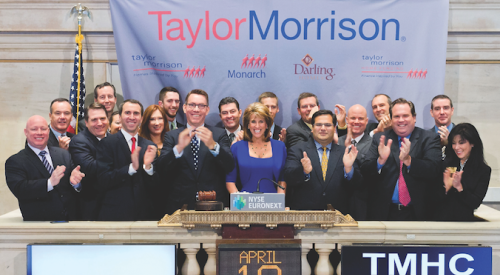|
The perception we have of 2006 as a bad year — especially for all those big production home builders now fighting excess inventories, cancelled sales and balky buyers in 2007 — doesn't stand up to close scrutiny of the actual year-end numbers reported by the Top 25 Housing Giants. For example, the average gross profit margin reported by the Top 25 in Professional Builder's Giant 400 survey was 23.32 percent for 2006. While that's down more than four full percentage points from the previous year, it's still a full point better than 2002, which was regarded — at the time — as a very good year for housing.
Of course, most of those margin points were racked up in the first half of 2006, when builders were still sucking the froth left over from 2005 pricing power. The trend line headed straight downhill in most markets during the second half of the year. Still, when the smoke clears at the end of this decade, we may see 2003 to 2006 as the anomaly and 2007 as a painful year of correction for the excesses of the Roaring 2000s in the middle. The trouble with those go-go years — when housing investors drove up prices to unsustainable levels in many markets — is that much of the home building industry believed they were looking at reality when what they really saw was a mirage.
|
 With prices retreating, investors gone and demand setting to a lower baseline, the largest home builders may have no choice but to shrink in size.  2006 seemed like a bad year for big builders mostly because the trend line tilted in the wrong direction -- but it might turn out to be just correction to sustainable levels of production. |
Those prices weren't real, and neither were the growth rates and margins of the largest builders, both public and private. And it wasn't just builders who got hooked on that mirage. Trades, product manufacturers and land sellers all benefited from the housing price run-ups, and they will balk at giving back their gains every bit as much as builders and their shareholders. But that's what the market seems to be saying has to happen. Check out the charts and graphs on these pages, showing Top 25 closings, revenues, market share and gross margins. We're showing five years of data because we think the numbers from 2002 may be in the general vicinity of where we're heading. But builders will have to get their costs back down to find margins at lower prices.
Smaller Companies?Wall Street housing stock analyst Ivy Zelman of Credit Suisse says No. 1 ranked giant Lennar Corp. and No. 7 NVR are doing the best jobs of managing their way through the current housing slowdown that began in 2006, but she believes all of the public companies will have to shrink to survive. "Lennar is slashing and burning inventories to keep utilizations up," Zelman says. "That's what they need to do: stay balance sheet focused. And NVR is set up to survive cycles. They don't have any land and their machine is the most efficient. They have the highest quality of operations. Land is not wine," says Zelman. "It does not get better with age."
She believes the majority of public builders will be losing money by the end of this year. "They have to shrink. If they did 40,000 closings last year, you can bet they'll be shooting for 20,000 to 25,000 this year. They will close some divisions, consolidate others and reduce head counts drastically. (Florida-based public Giant Technical Olympic USA just sold its Newmark Homes division in Dallas/Ft. Worth to Arlington, Texas-based private builder Steve Wall. See page 42.) They're going to have to be very aggressive on reducing their footprints. The top builder in the Giant 400 next year will have a lot fewer closings. It could be half.
"This is all about price," Zelman reasons. "If prices stabilize, we could see traffic pick up. But we think prices have to correct another 10 percent before that happens. There's still room for more correction before they get to the level of affordability that will move the market.
"The public builders are in more trouble than the private Giants," Zelman says, "because they have more land. At this point, I don't think any of the public builders will go down, but it depends on what they do now. If they shrink, they can survive."
In the 2002 Giant 400, Lennar was No. 1 with 23,899 closings for $5.47 billion in 2001 revenues, less than half of Lennar's size today in both closings and revenues. Is that where we're headed?
"There's no easy answer," says San Francisco-based housing stock analyst Carl Reichardt of Wachovia Securities. "What's the price needed to normalize the sales rate in the builder's communities? It's now clear that price is below cost, but a lot of builders have been slow to accept that fact. Prices are still too high relative to income levels.
"I'm not sure any of the public builders have managed their way through this slowdown very well," Reichardt says. "But at least Lennar was aggressive. [D.R.] Horton is great at fixed-cost control and field-cost control, but they gave away those advantages because they are so heavy on land. Most of the public builders reacted too much on the front end of the factory, cancelling land buys and stopping spec starts. The real problem is finished goods and near-finished goods inventories. Those have to be liquidated. They have to get out of the old communities with parabolic pricing curves. They need to open new stores that are not damaged by price falls, where the price and the product meet the demand that's out there in this new, emerging market."
Reichardt does not think any of the public builders will go down because they all entered this downturn with such strong balance sheets. "And if they all emerge wounded, but not dead — they will all be bidding for land against each other when the market comes back. No wonder land sellers are not dropping prices. The classic opportunity for buying land at the bottom of the cycle may not show up."
He thinks the current downturn may last another two years. "In the mid-1960s, we had a housing downturn without a recession. We had a couple of down years where the market compressed by 30 percent, then it flattened out for four years. That may be where we're headed."
On shrinking companies, Reichardt says it's certainly an option: "That's what MDC did in 1987. MDC might fold its tent today and go into a cave somewhere. Many shareholders would not be upset with that strategy. Liquidate as many assets as possible, accumulate a lot of cash and sit on it until the time is right to invest again. You don't keep your people, but who's hiring now? It is an option."
Another Wall Street insider who asked for anonymity said, "A lot of these companies are now selling a half a house a week at many of their subdivisions, when they need two or three a week to sustain the project. These guys need to keep their sales strong to burn through all this inventory. A 10 percent gross margin on a house sold today is better than a 5 percent gross next month. They should be cutting prices to whatever level is necessary to sell houses. At least that way, they'd find the right price and be able to work on costs to find some margin points."
Texas-based builder David Weekley's firm made the biggest jump in this year's Top 25, from No. 27 to No. 21: "The public builders went on a growth binge the last five years because they could, and Wall Street rewarded them for it," Weekley says. "This is the first time in 13 years that it's OK for the public builders to not grow. Their emphasis now is on profitability, but the pricing power is gone from virtually all their markets, even the ones where houses are still selling. As profits sink on the coasts, I think you'll see margins increase in Texas. The public builders now need to make money there; they won't be selling Texas houses at break-even anymore just to build up their volume."
Of course, that assumes the Texas market will stay strong, and even that's no sure thing.
|













